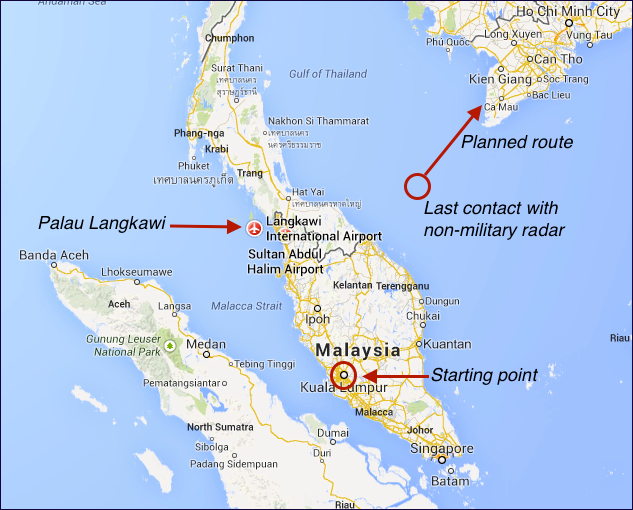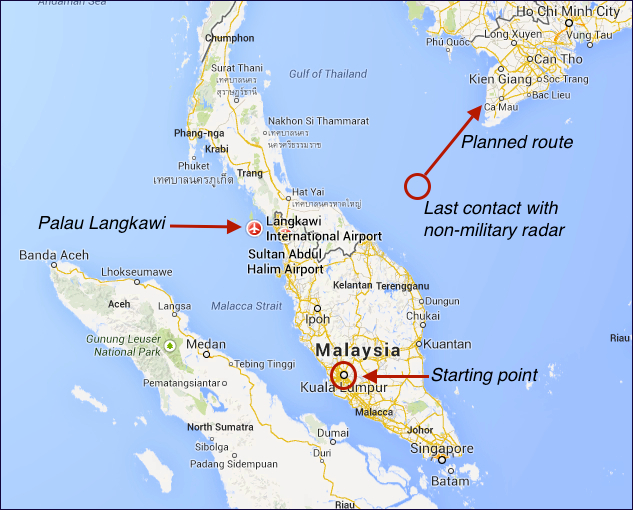New flight-computer data fuels the theory that Malaysia Flight 370 was hijacked


Ever since Malaysia Airlines Flight 370 disappeared in the early morning of March 8, there have been two basic theories to explain how the massive Boeing 777 with 239 people on board vanished: It crashed, or it was hijacked. Malaysia is now treating the lost flight as a criminal hijacking, and on late Monday U.S. officials bolstered that case, saying that the plane's initial turn off-course was programmed into the Flight Management System computer and was not the result of somebody manually steering the plane away from its Beijing destination.
Because the flight computer can only be programmed in the cockpit by somebody familiar with Boeing jets, it now seems unlikely that a passenger could have taken control of the jetliner. The new information, if true, doesn't do anything to illuminate why the pilots or a trained hijacker would have carefully veered the passenger jet off its planned course. If a hijacker or rogue pilot had wanted to crash the plane, there would be no point in turning off the communication and tracking devices and programming the flight computer — he would simply steer it into the ocean.
Chris Goodfellow, a veteran commercial pilot, plausibly hypothesizes that the captain piloted the plane off-course because of a fire in the cockpit or another major event onboard, and was headed to the closest large landing strip, at Palau Langkawi.
The Week
Escape your echo chamber. Get the facts behind the news, plus analysis from multiple perspectives.

Sign up for The Week's Free Newsletters
From our morning news briefing to a weekly Good News Newsletter, get the best of The Week delivered directly to your inbox.
From our morning news briefing to a weekly Good News Newsletter, get the best of The Week delivered directly to your inbox.

Instead of a nefarious hijacker, the pilot was likely "a hero struggling with an impossible situation trying to get that plane to Langkawi," Goodfellow says. But the pilots were incapacitated before they got it there, and the plane "just continued on the heading probably on George (autopilot) until either fuel exhaustion or fire destroyed the control surfaces and it crashed," he adds. "Smart pilot. Just didn't have the time." That's not the most optimistic theory, since it assumes that everyone is dead, but it has the air of nobility and simplicity. And it makes as much sense as the other explanations out there.
A free daily email with the biggest news stories of the day – and the best features from TheWeek.com
Peter has worked as a news and culture writer and editor at The Week since the site's launch in 2008. He covers politics, world affairs, religion and cultural currents. His journalism career began as a copy editor at a financial newswire and has included editorial positions at The New York Times Magazine, Facts on File, and Oregon State University.
-
 Film reviews: ‘Marty Supreme’ and ‘Is This Thing On?’
Film reviews: ‘Marty Supreme’ and ‘Is This Thing On?’Feature A born grifter chases his table tennis dreams and a dad turns to stand-up to fight off heartbreak
-
 Political cartoons for December 14
Political cartoons for December 14Cartoons Sunday's political cartoons include a new White House flag, Venezuela negotiations, and more
-
 Heavenly spectacle in the wilds of Canada
Heavenly spectacle in the wilds of CanadaThe Week Recommends ‘Mind-bending’ outpost for spotting animals – and the northern lights
-
 Nobody seems surprised Wagner's Prigozhin died under suspicious circumstances
Nobody seems surprised Wagner's Prigozhin died under suspicious circumstancesSpeed Read
-
 Western mountain climbers allegedly left Pakistani porter to die on K2
Western mountain climbers allegedly left Pakistani porter to die on K2Speed Read
-
 'Circular saw blades' divide controversial Rio Grande buoys installed by Texas governor
'Circular saw blades' divide controversial Rio Grande buoys installed by Texas governorSpeed Read
-
 Los Angeles city workers stage 1-day walkout over labor conditions
Los Angeles city workers stage 1-day walkout over labor conditionsSpeed Read
-
 Mega Millions jackpot climbs to an estimated $1.55 billion
Mega Millions jackpot climbs to an estimated $1.55 billionSpeed Read
-
 Bangladesh dealing with worst dengue fever outbreak on record
Bangladesh dealing with worst dengue fever outbreak on recordSpeed Read
-
 Glacial outburst flooding in Juneau destroys homes
Glacial outburst flooding in Juneau destroys homesSpeed Read
-
 Scotland seeking 'monster hunters' to search for fabled Loch Ness creature
Scotland seeking 'monster hunters' to search for fabled Loch Ness creatureSpeed Read
